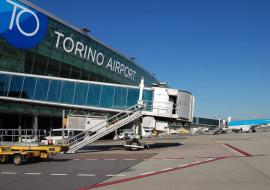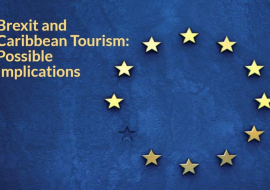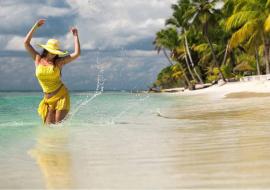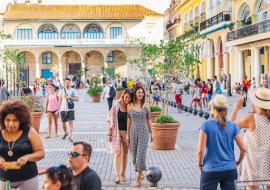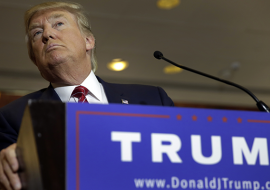7 Days in Cuba on $700

Below the departures level at JFK's JetBlue terminal, in a corner near baggage claim, a queue was forming. Right now, there's only one flight from New York to Havana per week—a JetBlue charter operated by Cuba Travel Services—and judging from the number of fedoras up ahead, I knew this was the right line for check-in.
I also knew there'd be cheering when we touched down at the end of the 3-hour flight, and to pay a taxi driver $25 to take us to our first stop, the U.S. Embassy. But there, where Secretary of State John Kerry had raised the American flag just that morning, here's what else I knew: I had a couple hundred bucks, a smart phone diminished to a picture-taking piece of glass, and a week of unknowns ahead.
There's no shortage of info about how U.S. citizens can visit Cuba, legally or otherwise (the rules keep loosening, but to go with JetBlue, you must fall under one of 12 approved categories of travel), and American visitors are advised to bring enough cash to last the duration of their stay.
Since President Obama announced that the U.S. is reestablishing relations with Cuba, MasterCard has reportedly unblocked transactions for U.S.-issued cards there, but cardholders still need to make sure their issuing bank is on board, and in general, there aren't many places to use a credit or debit card on the island.
Deciding how thick of a wallet to bring depends, of course, on how you like to travel. Cuba's high-end luxuries aren't on the level of other Caribbean destinations, but the island will quickly price out backpackers used to a Southeast Asian or South American budget. Right now, the socialist nation is in expansion mode, rushing to improve its infrastructure as it draws record-high interest in tourism and foreign investment. My traveling partner and I were interested in seeing what life is like for residents trying to tap into the tourist boom. No hotels, no group excursions.
Relying on some prior Google-assisted research, a few advance payments, and a passable fluency in Spanish to lower the clueless tax, we ended up spending under $700 altogether in one week, excluding our individual initial expenditures: the $949 direct round-trip flight, $85 visa, and $25 Cuba exit fee, as well as a $44 one-night Airbnb reservation paid online. Here's how we did it.
Currency: 1 CUC = $1 USD
Cuba has two currencies: Residents use the Cuban peso (CUP or MN for moneda nacional), and foreigners and investors use the Cuban convertible peso (CUC), which is pegged to the dollar 1:1 and worth 25 times more than the Cuban peso. Most residents, unless they're self-employed, are paid by the government in CUPs and earn $15 a month on average—just enough to cover basic needs and bills. That salary also goes for highly trained occupations like computer engineers and lawyers: We met an ex-lawyer who quit his $15-per-month job to become an independent taxi driver—he now makes $5 per ride.
Spending and tipping with CUCs at private businesses, including B&Bs and restaurants, helps support Cubans directly. In Havana, even CUCs spent at nationalized shops and restaurants help fund much-needed restoration projects for schools, clinics, and local housing, The Atlantic reports. Note there is a 10 percent tax for exchanging USD (on top of the exchange commission); avoid it by bringing your cash in Euros or Canadian dollars.
Accommodations: $25-40 a night
A night at Hotel Saratoga, arguably Havana's chicest hotel (and also where Beyoncé and Jay Z checked in), starts at $246 for a deluxe two-person suite. Alternatively, you can stay in casa particulares, Cuban homes that legally rent out rooms to foreigners. Airbnb tapped into this existing network of private bed and breakfasts when it launched in Cuba this year, open only to U.S. citizens traveling under the approved categories. The beautiful Airbnb we booked for a one-night stay, located right on the Malecón near Old Havana, cost $40 a night.
You can easily identify a casa particular by the white and blue sign posted outside the home. Just ring the doorbell—or holler—and the hosts will show you whatever room is vacant. A room for two goes for about $35 a night in Havana, though prices are rising as more and more tourists land in the capital ("I don't have shoes, but I have a brand new kitchen," said one host, whose family in Miami helped her open a B&B business after news of the U.S. thaw broke). Renting a room is even cheaper in Viñales, a tobacco and coffee farming village southwest of the capital, home to a national park of limestone cliffs and verdant hills.
Food: Up to $15 per person a meal (not including drinks)
Most restaurants are state-run, taken over by the government during Cuba's socialist revolution. There, super-sized entrées can go for $5-10, while smaller plates and appetizers are usually under $5. We had an $8 breakfast consisting of a pitcher of mango juice, two drip coffees, and a plate of fried eggs, toast, ham, chorizo, and fresh fruit. Our tab at Flor De Loto, a line-out-the-door Chinese restaurant in Havana's faded Chinatown, came to about $15 (excluding cocktails) for an appetizer and two main dishes. This order would feel paltry in New York's Chinatown, but trust me: In Cuba, the portions are massive.
We preferred the eats and the heavier-handed seasoning at the paladares, or independent restaurants. For $1, we had a breakfast of two coffees and what were basically two delicious hot dog sandwiches. For $2 a dish, we binged on a Japanese ex-pat's karaage, katudon, and tonkatu. Street food for $1 or less—ice cream cones, churros, pizza, and Panini-pressed sandwiches—are popular with both locals and foreigners. But the most epic meal of all—perhaps even the largest meal of my life, plate for plate—was served at Finca Agroecologica El Paraiso, a family-owned farm and restaurant in Viñales. Eighteen farm-fresh entrées of vegetables, meats, fish, and soup, one after another, kept piling on top of our table for two. They brought in a whole pig on a grill. We were given a bottle of white Havana Club rum to pour into our drinks. There was coffee and dessert. Their price? "$10 each, nothing if you didn't enjoy," the owner told us.
Drinks, Non-Alcoholic: 25 cents and up
A drip coffee (what Cubans call "expresso") costs a few coins at refreshment stands and in most paladares; in other bars, cafes, or restaurants, the same cup could cost $3. Bottles of water and cans of soda and beverages like Bucanero malt are $1, and so are the fresh sugarcane juices you can get on a farm in Viñales. I paid $2 for a fresh coconut.
The Alcoholic Stuff: $1 and up
A can of Cerveza Cristal costs $1. Draft beer and mixed drinks (like the obligatory mojito) run about $3 at bars, restaurants, nightclubs, and live music venues. Thanks to Ernest, El Floridita in Havana charges $6 for a daiquiri—the most expensive we saw. A one-liter bottle of white Havana Club rum, our go-to for making Cuba libres on the Malecón, starts at $5.
Transportation: $5 per taxi ride, on average
Bulbous yellow taxis, called cocotaxis, take tourists around the city (with the exception of the airport) for less than $8. You can take a private taxi for less, usually $5 a trip, but expect a markup for the more nicely maintained Soviet-era cars. We walked nearly everywhere in Havana but took a private taxi with an American couple for $15 a head to Viñales, a three-hour drive from the city (it was the same cost as the bus). Renting two bicycles in Viñales cost us $10 for a day; a scooter, $24.
Wi-Fi: $4.50 per hour
For Wi-Fi on your phone or laptop, you'll need to purchase an Internet card with a lotto-style scratch-off password. $4.50 gets you one hour of Internet access. You can buy these cards at higher-end hotels (many also have business centers with online access) and wherever there's a hotspot.
Cigars: Pennies to $31
Americans can bring back $400 in souvenirs, and $100 of that can be spent on tobacco. In Viñales, where much of the country's tobacco is harvested, we bought a single cigar straight from its plantation for $3. A single Cohiba, the top brand in Cuba, can go for $31. Just want a bunch and don't care about the brand? It's possible to buy a pack of 25 for $2 from local shop owners.
We spent a good part of our last few days getting to know one of these shop owners, an energetic 52-year-old named Felix Guirola, who has made headlines around the world for his personal hobby: building super tall bikes. Felix said a French cyclist is paying to fly him out to Switzerland next year, where the two will bike together. The logistics of this trip are not unlike many things for Cubans today: somewhat uncertain.
Yet on the flight back to New York, we sat next to a young Cuban woman moving to Brooklyn, where she has a restaurant job lined up. While we chatted, she tried Doritos for the first time. There was applause again when we landed at JFK. And after that, for many, a whole world of unknown things to discover.
Source: Esquire







